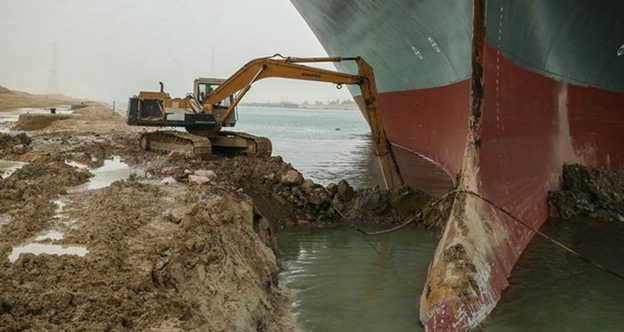
The container ship Ever Given has been blocking the Suez Canal for days. Economic fallout is already visible, and it could take weeks — and require drastic measures — to free the waterway.
Tugboats and dredgers have so far failed to free a the cargo ship ‘Ever Given’ wedged in the Suez Canal. The situation is creating a traffic jam with approximately 200 vessels waiting on both sides of the canal, reported Deutsche Welle.
In addition to oil, consumer goods such as clothing, furniture and auto parts are transported across the channel. Richard Medae of Lloyd’s List wrote on Twitter that westbound traffic was estimated to be worth about $5.1 billion (€4.3 billion) a day. Eastbound traffic is worth some $4.5 billion. This means that about $10 billion worth of goods are now blocked.
The head of Egypt’s Suez Canal Authority, Osama Rabie, said Saturday that “technical or human errors” may be to blame for the grounding of a giant container ship in the crucial waterway.
Authorities are working to free the vessel, named the Ever Given, which has been wedged diagonally across the span of the canal since Tuesday, blocking the shipping route in both directions.
Rabie told reporters that the ship could possibly be refloated by Sunday evening.
“We could finish today or tomorrow (Saturday or Sunday) depending on the ship’s responsiveness” to tides, Rabie said. “We expect that at any time the ship could slide and move from the spot it is in.”
Officials previously said strong gusts and a sandstorm had caused the ship to run aground. But Rabie said “weather factors were not the main reasons for the ship’s grounding.”
“There may have been technical or human errors.”
Hundreds of ships delayed
The blockage has caused a huge traffic jam of more than 300 ships along the 193-kilometer (120-mile) canal, and caused major delays in the delivery of oil and other products. Some companies have even been forced to consider re-routing vessels around the southern tip of Africa.
The vessel’s Japanese owner had voiced hope on Friday that the ship could be dislodged by late Saturday.
“The ship is not taking water. There is no problem with its rudders and propellers. Once it refloats, it should be able to operate. We are continuing work to remove sediment as of now, with additional dredging tools,” said Yukito Higaki, president of Shoei Kisen KK, which owns the ship.
The parent company of Dutch firm Smit Salvage, which is in charge of the salvage operation, said the ship would only likely be afloat again “at the start of next week.”
Crews have been working overnight with large dredging machines under floodlights in an attempt to free the ship, which is about the size of the Empire State Building in New York.
Dredgers have so far removed more than 20,000 tons of sand from around the ship’s bow, while 14 heavy tugs have been brought in to assist.
How are they trying to free the Ever Given?
The Ever Given, operated by the Taiwanese company Evergreen Marine, is the length of four football pitches and is lying across the southern end of the canal preventing other ships from getting through one of the world’s busiest waterways.

The ship is 400m (1,300ft) long, wedged diagonally across a canal not much more than 200m (656ft) wide.
Using cables or placing themselves directly alongside the stricken ship, the tugs have been trying to move the ship off sand banks on both sides of the canal.
As it’s firmly grounded on both banks, all efforts to shift it so far have proved unsuccessful, says Sal Mercogliano, an expert in maritime history at Campbell University in the US.
The company which manages the running of the vessel, Bernhard Schulte Shipmanagement (BSM) said an attempt to refloat the ship on Friday had failed but that efforts would continue.
The company says two further tugs are due to arrive on Sunday to assist in the operation. The focus is now on digging out sand and mud from under the bow of the vessel.
Sal Mercogliano says these dredgers are a familiar site on the Suez Canal, used to continually dredge the waterway to keep it navigable. “Large machines stick down into the water and basically pull dirt up from the bottom, which you can then deposit onshore.”
BSM says an additional specialist “suction dredger” is now in place able to shift 2,000 cubic meters of material every hour. The Netherlands-based company Boskalis is managing the dredging operation.
Its chief executive Peter Berdowski says dredging alone won’t resolve the problem. “It might take weeks depending on the situation” to free the ship using a combination of dredging, tugging and the removal of weight from the vessel.
A further option in efforts to re-float the 200,000 tonne vessel is to remove fuel, water and cargo.
Draining fuel from the ship’s tanks would help, but is unlikely to be sufficient without other load-lightening measures.
Some internal spaces within the hull of the boat contain water, and the managing agent BSM says arrangements are being made to reduce these levels using high-capacity pumps.
A ship the size of the Ever Given can carry as many as 20,000 twenty-foot containers and an operation to remove these by crane would be highly challenging.
Apart from the difficulties associated with getting suitable cranes close enough to the ship, the process could cause damage and even unbalance the ship.
“You would have to bring large floating cranes – but anything you do right now you would have to determine how it would affect the ship’s stability,” says Dr Mercogliano.
“Worst case scenario is that she breaks in half because of [uneven] weight distributions.”



